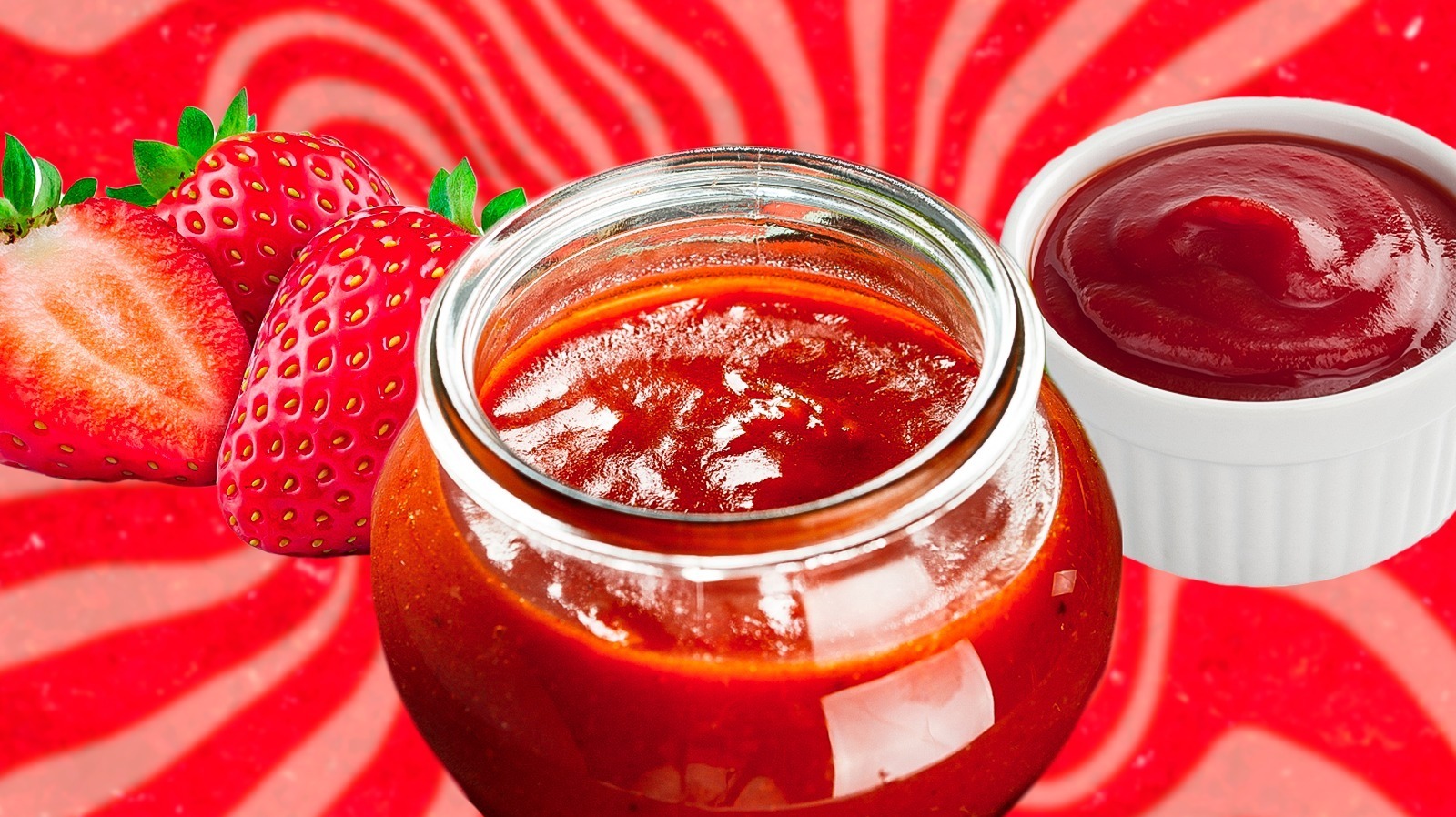There are few condiments more iconic than ketchup. Between its bright red color, sweet-tangy taste, and versatile deliciousness, ketchup has become a staple in American cuisine. For most people, tomatoes come to mind when they think of ketchup, but you might be surprised to learn that tomatoes are not what makes the sauce ketchup. Instead, “ketchup” is a general term that refers to a pureed sauce, and it can be made with ingredients other than tomatoes — including strawberries.
Enter strawberry ketchup, a condiment that will likely spark intrigue or disgust, depending on how adventurous and curious you are when it comes to food. As the name suggests, the sauce is a type of ketchup made with strawberries, either in place of tomatoes or in combination with them. The result is a unique strawberry recipe that’s sure to turn heads at your next barbecue or picnic.
If you’re having a hard time wrapping your head around strawberry ketchup, consider the long and complex history of the sauce. The original ketchup, which has been traced back to the 3rd century BC, started out as a fish sauce known as “ge-thcup” or “koe-cheup.” It was made by fermenting fish entrails and soybeans, resulting in a bright and tangy condiment with a long shelf-life. By the 19th century, ketchup was being made in England and the U.S., but with ingredients like walnuts, oysters, mushrooms, and fruits like peaches, plums, and lemons. Needless to say, it was only a matter of time before strawberries were added to the list.
Although strawberry ketchup will likely never achieve the same popularity as tomato ketchup, it’s something worth trying if you’re looking to switch up your condiment game. Here’s a detailed breakdown of the sauce, plus tips for making and using strawberry ketchup at home.
What is strawberry ketchup?
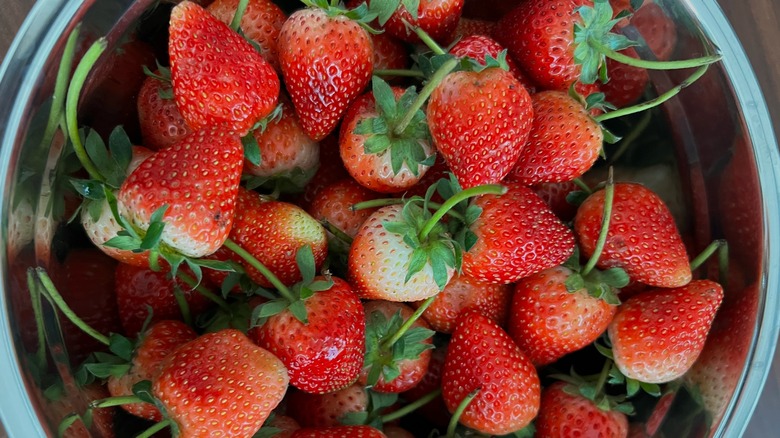
Strawberries are bright red fruits that are part of the rose family. They’re often eaten on their own, blended into smoothies, or prepared in sweet or savory dishes, though they can also be used to make popular condiments (like strawberry sauce for ice cream) and spreads (like strawberry jam). However, these options are sweet, so it’s unlikely you’ve heard of strawberry ketchup until now.
In general, strawberry sauce is a pureed condiment made of strawberries, vinegar, soy sauce, and a sweetener. It might sound strange, but when you consider the similarities between strawberries and tomatoes, the condiment makes sense. Strawberries have a similar acidity to tomatoes, so they provide the same level of tang when used in sauces. Additionally, as strawberries are naturally red, ketchup made with the fruit is red just like regular ketchup — so if the idea of non-red ketchup weirds you out, strawberry ketchup might be the way to go.
The exact origins of strawberry ketchup are unknown, but in 2013, chef Edward Lee shared the condiment in his book “Smoke & Pickles: Recipes and Stories from a New Southern Kitchen”. The ketchup was part of a recipe for steak tartare — a French dish made with raw ground beef and raw egg yolk — and sesame oil. Otherwise, a quick internet search shows that there are many online recipes for strawberry ketchup created by home chefs.
How is it made?
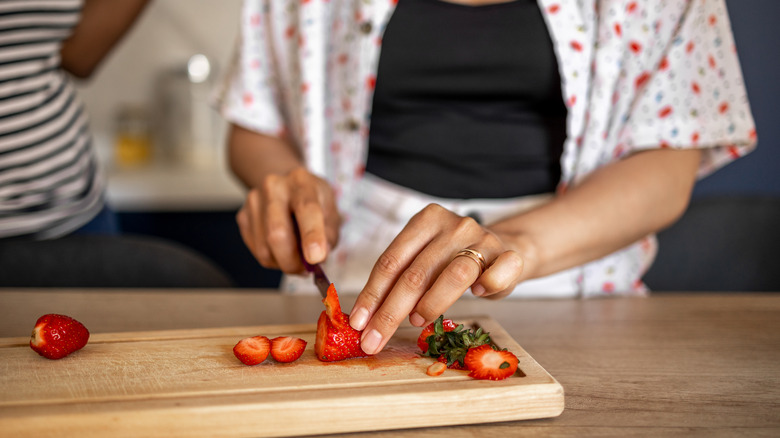
As with all homemade condiments, strawberry ketchup can be made in many ways. Most recipes start with cutting fresh strawberries into slices, though you can use frozen ones as well. If you decide to use frozen strawberries, consider ones that have already been sliced or quartered, as they’ll cook more quickly. The strawberries are simmered on the stovetop with onions, soy sauce, and vinegar, all of which provide the salty and savory notes that complement the fruit. The mixture is then pureed in a blender or food processor and strained, ensuring the finished condiment is smooth. If you don’t mind a thicker sauce, you’re welcome to skip the straining step.
In some recipes, the pureed mixture is returned to the stovetop to add spices and seasonings, then simmered and strained again. Cooking the ingredients before pureeing is a great way to caramelize the onion and deepen its taste and color, providing a complimentary flavor profile for the berries. Just be sure to let the mixture cool slightly before adding it to the food processor or blender; pureeing hot ingredients can release steam and increase pressure in the appliance, potentially causing the top to fly off.
Yet another option is to puree the raw ingredients first, then simmer the mixture until thick and reduced. If you decide to use this method with frozen strawberries, you’ll want to let them thaw slightly for easier blending, especially if your food processor or blender isn’t very powerful.
Strawberry ketchup vs. tomato ketchup
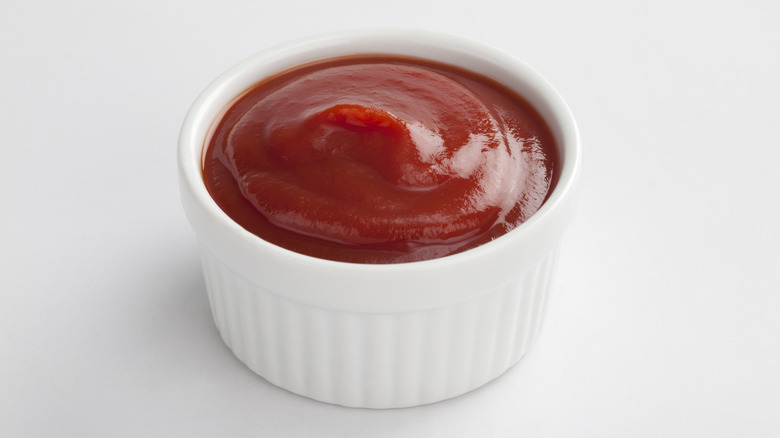
Since ketchup can be made with so many types of ingredients, the exact flavor can vary. However, ketchup in general is made with vinegar and a sweetener, so it typically tastes tangy, sweet, and salty. Older varieties of ketchup were more tart than sweet, while modern-day ketchup tends to be tomato-based and sweeter. It’s all thanks to the iconic company Heinz, which released a sweet tomato ketchup in 1876, making the ketchup variety we know and love today.
Strawberry ketchup is usually less cloying or excessively sweet than classic tomato ketchup. This is partly due to the homemade nature of the condiment, as you can easily adjust the amount of sweetener to suit your taste buds and balance the natural sweetness from the strawberries. Also, unlike tomato ketchup, strawberry ketchup has a berry flavor that might be more intense if a recipe incorporates strawberry jam as well.
In terms of texture, strawberry ketchup that has been strained will have a similar consistency to tomato ketchup. The process of straining removes any solid pieces, resulting in a smoother sauce. However, it’s not a necessary step, and you can certainly skip the straining step. The final unstrained product will be thicker and chunkier, but it will still taste delicious.
What does strawberry ketchup taste like?
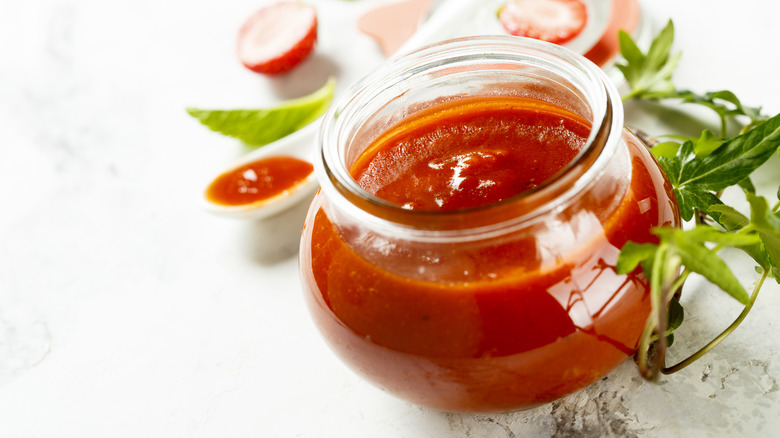
MariaKovaleva/Shutterstock
Strawberry ketchup has a distinct sweet berry taste, but it’s also tangy and salty due to the vinegar and soy sauce. Again, the exact flavor profile will depend on the ingredients, particularly the type of vinegar used. For example, strawberry ketchup made with balsamic vinegar will have a more smoky, caramelized flavor than a version made with white vinegar. If you use apple cider vinegar, the finished product will have a slight apple taste and smell. Red wine vinegar in strawberry ketchup will impart a strong grape-like brightness, which might be ideal if you like more pungent condiments.
The flavor of strawberry ketchup is also determined by the spices and seasonings used (if any at all). Salt and ground black pepper are popular candidates, but other spices like cloves, cumin, smoked paprika, powdered ginger, nutmeg, cinnamon, and curry powder can be added to the condiment. In this case, the ketchup will have a variety of warm flavors that play well with its natural sweetness.
If a strawberry ketchup recipe calls for tomato paste or tomato puree, chopped tomatoes, or actual tomato ketchup, there will be notes of tomato in the condiment as well. However, the condiment will still be more savory than other popular strawberry condiments, such as fruit sauce or jam.
How do you cook with strawberry ketchup?

Strawberry ketchup is used just like tomato ketchup: As a spread or dip, typically as-is and without additional heating. The flavor perks are also similar, thanks to the sweet tanginess of the condiment. Spread it on sandwiches, burgers, wraps, or hot dogs, or use it as a dip with finger foods like chicken fingers, onion rings, and French fries. Essentially, anything you’d normally eat with regular ketchup is fair game. Strawberry ketchup will add a unique level of berry-infused sweetness that balances savory and salty foods alike.
Strawberry ketchup can be used to make other types of sauces, too. For example, barbecue sauce is typically made with tomato ketchup, but using the strawberry variety will add a subtle sweetness. Its berry flavor pairs wonderfully with the meaty, savory notes of pork chops, steak, or burgers. Normal ketchup can also upgrade stir-fry sauce, but using the strawberry version will instantly switch things up. Craving something lighter? Turn strawberry ketchup into a tangy berry vinaigrette by mixing it with extra-virgin olive oil, vinegar, and dried herbs.
You can also use strawberry ketchup in cooked recipes, such as meatloaf and shepherd’s pie. In both dishes, the condiment will add moisture and flavor without the excessive sweetness of typical tomato-based ketchup. It can be especially tasty in a meatloaf glaze, mixed with brown sugar and Worchesthire sauce. For a meat-free option, try using strawberry ketchup to make baked beans or lentil sloppy joes for a fruity twist.
Where can I find strawberry ketchup?
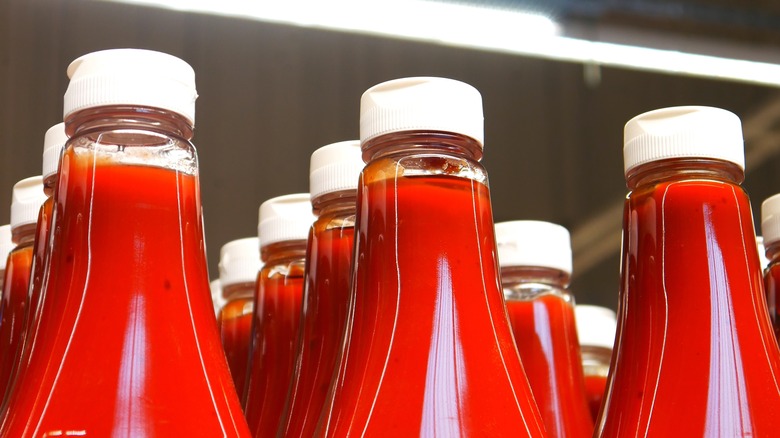
Strawberry ketchup is a novelty item, so it’s not sold in grocery stores, and a quick search on Amazon yields no results for the product. The shops at strawberry farms might sell strawberry ketchup or similar savory, vinegar-based sauces, but otherwise, you’ll need to make it at home from scratch if you want to enjoy the condiment. Thankfully, the ingredients are easy to find.
The key to making the best strawberry ketchup is to start with ripe, high-quality strawberries. When shopping for strawberries at the supermarket, look for ones that are bright red and have vibrant green leaves. These signs indicate peak ripeness and therefore, a good, sweet taste that will properly balance the tangy notes of the sauce. Avoid strawberries that are white around the stem, as this means they’re unripe and will likely taste bitter or sour. Strawberries don’t ripen over time, so if you were to use unripe fruits in homemade ketchup, the result would be disappointing.
If possible, choose strawberries that are on the smaller size. It might seem counterintuitive, but smaller and medium berries taste better than bigger ones. That’s because larger strawberries contain more water than juice, resulting in a diluted berry flavor. While you’re at it, steer clear of strawberries with bruises, mushy spots, and discoloration, all of which mean they’re on their way out.
Is strawberry ketchup healthy?
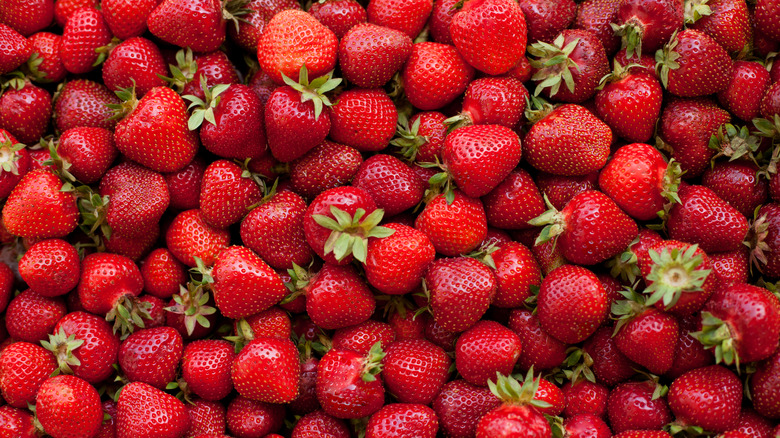
Strawberries contain many essential nutrients, including immune-boosting vitamin C and gut-friendly fiber. They’re also packed with compounds called anthocyanins. As plant pigments, anthocyanins give strawberries their bright red color, but they also act as antioxidants. This means they protect cells from damage, potentially reducing the risk of disease. Making strawberry ketchup is a fun way to boost your intake of the fruit and get more of these nutrients, especially if you typically don’t eat strawberries on their own.
Plus, homemade sauces in general tend to be healthier than store-bought versions, which are often packed with sugar and salt. Consuming too much of either one increases the risk of health issues over time, so you might be looking to reduce your intake. By making your own ketchup (with strawberries or otherwise) you’ll be able to adjust the sugar and salt to meet your needs, allowing you to enjoy the condiment in a healthier way. For example, while strawberry ketchup contains sugar, it’s typically less sugary than store-bought ketchup as the strawberries are naturally sweet.
Of course, just because strawberry ketchup is healthier than traditional versions doesn’t mean it’s a “health” food. It still contains sugar and salt, which should be enjoyed in moderation, particularly if you’re managing certain chronic diseases. That being said, strawberry ketchup certainly has a place in a balanced diet, but it shouldn’t be your only source of fruit.
Varieties of strawberry ketchup
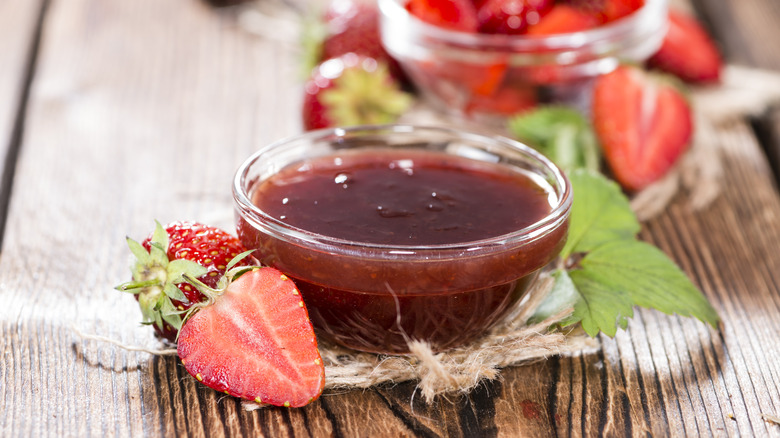
As a primarily homemade condiment, strawberry ketchup varies by recipe. The most common kind is made with just strawberries, which allows the berry flavor to take center stage. However, it can be made in combination with other ingredients, such as bell peppers or mushrooms. Some varieties can be considered strawberry-tomato ketchup, as they’re made with canned tomatoes, tomato puree, or sun-dried tomatoes, which give the sauce a more traditional ketchup flavor that many people know and love. This might be ideal if you’re not quite ready to try strawberry-only ketchup.
If you’re feeling experimental, strawberry ketchup can be created with other berries as well. Simply replace some of the strawberries with another type of berry, such as blueberries, blackberries, or raspberries. Blueberries tend to be milder and less tart than blackberries or raspberries, so feel free to choose one that suits your taste buds. For a unique mixed berry ketchup, use a combination of fresh or frozen berries in place of strawberries.
On that note, some versions of the condiment don’t use fresh strawberries at all. This variety can be made by mixing strawberry preserves with store-bought ketchup, along with lemon juice and onion powder. No heat is necessary, so you might appreciate this approach if you want a no-cook version that can be whipped up in minutes.
How do you store strawberry ketchup?
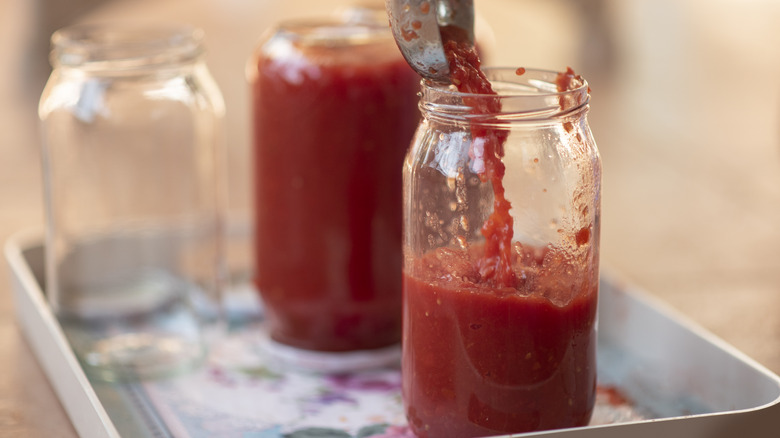
Due to its homemade nature, strawberry ketchup is best enjoyed immediately. But unless you’re serving a crowd, it can be difficult to eat an entire batch of the condiment on your own. In this case, it’s important to be mindful of how you store the ketchup. This will determine its lifespan, and ultimately, how long you can safely enjoy the condiment.
While strawberry ketchup contains natural preservatives like vinegar and salt, it’s also made with fresh fruits, which can shorten its overall shelf-life. What’s more, homemade sauces in general don’t have the same chemical preservatives as store-bought condiments, particularly bottled ketchup, so they won’t last as long. To store strawberry ketchup properly, keep it in an airtight container, such as a mason jar or a bottle with a stopper lid. Glass containers are best, as the acidity in strawberry ketchup can interact with plastic.
Strawberry ketchup will last about one week in the fridge. If the sauce develops mold, discoloration, or a funky off-putting smell, be sure to toss it, as these signs indicate spoilage. To keep strawberry ketchup for longer than one week, pour it into an ice cube tray and freeze until solid. You can then transfer the ketchup cubes into an airtight freezer-safe container, like a resealable silicone bag, and store them in the freezer for up to three months. When you’re in the mood for strawberry ketchup, simply defrost a cube or two overnight in the refrigerator.



